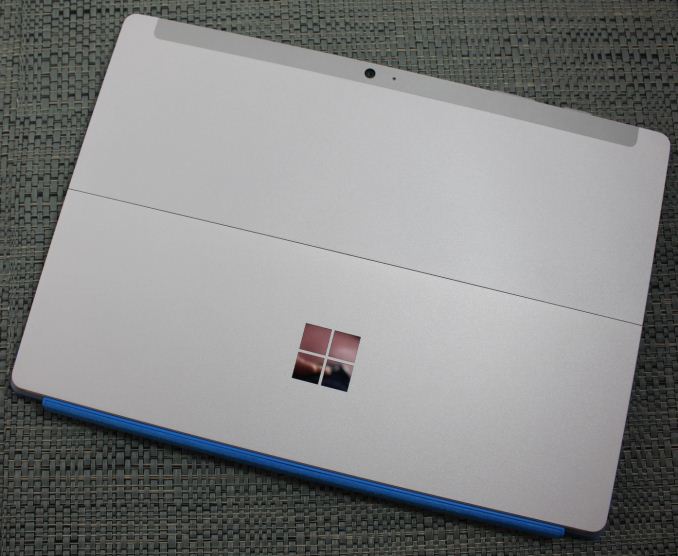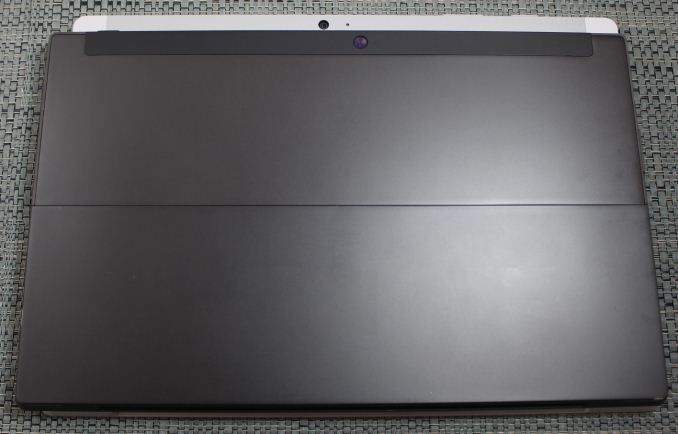The Surface 3 Review
by Brett Howse on May 4, 2015 9:00 AM EST
The Surface lineup for Microsoft has been extremely interesting to watch. What first launched in October 2012 as the Surface RT has been constantly iterated upon, and of course the Surface Pro line has evolved even faster. Surface Pro 3 has finally provided Microsoft with something that critics and consumers alike seem to have bought in to, and sales have been very strong since the Pro 3 was launched on May 20th 2014. However there has always been questions about the “consumer” version of Surface. Surface RT was, frankly, a sales disaster. The much improved Surface 2 fixed many of its shortcomings, but certainly did not set the world on fire. So now we have the third generation Surface, aptly named the Surface 3. There are a pile of changes that Microsoft has made to this generation of device, and obviously their hopes are that Surface 3 will be as popular as the Surface Pro 3 has been, but extending the device back down to a lower price point.
That price point is important. As much as the Surface Pro 3 has gained its share of fans, it is far from cheap. The most inexpensive model starts at $799, and for that you still do not get the keyboard. Surface 3 moves that bar down significantly, and the starting price is the exact same as the original Surface RT, at $499. Microsoft had to trim down the Pro model to hit this price point, but the cuts were well placed.
 Surface RT compared to Surface 3
Surface RT compared to Surface 3
I think looking at the Surface 3 in a vacuum would be improper, since the device now is really an evolution of the previous two Surface models. From a build quality standpoint, the original Surface RT was top notch, with its VaporMg case, the revolutionary kickstand, and high attention to detail for all of the aspects from buttons to display. I think in 2015 it is pretty obvious what the shortcomings of the Surface RT were though. Performance was less than acceptable with the Tegra 3 SoC on board, and Surface RT was handicapped with the confusingly named Windows RT operating system and the lack of software compatibility that goes with using an ARM CPU instead of traditional x86. Surface 2 fixed the performance issue by moving to NVIDIA’s Tegra 4 SoC, and while not the outright fastest tablet chip, it was at least in the ballpark. However it kept the Windows RT operating system at a time when everyone else had abandoned it.
Surface 3 has fixed that final issue and at the same time made some amazing improvements to the overall design and feel. Full x86 Windows is on tap, for better or for worse, and powered by a brand new SoC. This must be a special moment in history where a Microsoft built device is the launch vehicle for a brand new product from Intel. The Surface 3 is powered by the 14nm Intel Atom x7, in this case the x7-Z8700 model which is the current top of the line Atom processor. Codenamed Cherry Trail, this is the massaged Bay Trail cores now built on Intel’s now mature 14nm FinFET process, and they include the same GPU cores as Broadwell.
| Microsoft Surface Comparison | |||
| Surface 3 (Base) | Surface 3 (High) | Surface 2 | |
| Size | 10.52 x 7.36 x 0.34 inch 267 x 187 x 8.7 mm |
10.81 x 6.79 x 0.35 inch 275 x 173 x 8.8 mm |
|
| Weight | 1.37 lbs - 622 g | 1.49 lbs - 675 g | |
| Display | 10.8-inch ClearType Full HD Plus 1920x1280 resolution, 3:2 ratio 10-point multi-touch Surface Pen Support |
10.6-inch ClearType Full HD 1920 x 1080 resolution, 16:9 ratio 5-point multi-touch |
|
| Battery | 28 Wh, 13 W AC Adapter | 31.5 Wh, 24 W AC Adapter | |
| Storage | 64GB | 128GB | 32GB or 64GB eMMC |
| RAM | 2GB | 4GB | 2GB |
| CPU | Atom x7-Z8700 Quad Core 14nm 1.6 GHz Base Frequency 2.4 GHz Burst Frequency |
NVIDIA Tegra 4 4x ARM Cortex-A15 @1.7GHz |
|
| WiFi | Marvell 802.11ac + BT 4.0 LTE Models at a later date |
802.11n + BT 4.0 | |
| Ports | USB 3.0, Mini-DisplayPort, microSD, Micro USB charging, 3.5mm Headset Jack |
USB 3.0, micro-HDMI, microSD, proprietary charging | |
| Software | Windows 8.1 Office 365 Personal with 1TB OneDrive (1-year) |
Windows RT 8.1 Office 2013 RT Home & Student Edition |
|
| Front Camera | 3.5 MP | 3.5 MP | |
| Rear Camera | 8.0 MP with Autofocus | 5.0 MP | |
| Operating System | Windows 8.1 64-bit | Windows RT 8.1 | |
| Warranty | 1-year limited | 1-year limited | |
| Price | $499 | $599 | $449 |
In addition to the new SoC, Surface 3 can be purchased with up to 128 GB of eMMC storage, and the higher storage models also come with 4 GB of RAM. This compares to the base model which is 2 GB of RAM and 64 GB of storage, which is already one of the big improvements Microsoft has made with Surface. 32 GB of storage on a Windows tablet is really the bare minimum required, and the move to 64 GB as the base is going to make this tablet far more usable. You can of course add more storage with a micro SD card, but until Windows gets the great SD card support from Windows Phone, it still means that you need to manage your storage more than you should have to.
There are so many changes with the Surface 3 that really, this is likely the Surface that most people wanted from day one, but did not know it. First up is the new (again) kickstand.










265 Comments
View All Comments
MrTetts - Tuesday, May 5, 2015 - link
The IPad is ALWAYS going to be an inferior product regardless of use case.1. For video/media consumption - you would have access to more media players, more content markets (than just the itunes store) and simply more choice overall.
2. For media/content creation - You do not even have this option (or intergrated well enough) on an IPad.
3. Basic office duties - We can all agree that any office applications on an IPad would be very watered down and frankly quite useless. If you have to buy a keyboard to access an application properly on an ipad, then my friend, I have news for you... your use case clearly aligns you to a surface 3.
An IPad is no where near up to par. You are getting a very big IPod Touch for your money. Don't give in to the marketing from Apple telling you you can be productive on an IPad.
zhenya00 - Tuesday, May 5, 2015 - link
No, just no. I could make a list 3 times as long as yours detailing the ways that an iPad is superior to any Windows tablet. And I own several iPads and two Surface Pros. Frankly I'm just tired of having to counteract this kind of FUD.romprak - Tuesday, May 5, 2015 - link
I have 3 iPads at home (first gen, 3rd gen, and Air) - and his list seems quite accurate to me. One reason I've started transitioning our children after they are 6 years old to Surfaces and/or Macs. I am a little sad at how much money we've wasted on iPads, I certainly will not be doing that any longer.With our Macs and Surfaces, the children are actually learning how to do stuff and not be passive observers.
lolstebbo - Tuesday, May 5, 2015 - link
The only mental block I'm having right now is does Microsoft even have some sort of equivalent to iMovie? That's the one thing on the Mac side that I don't have a Windows-compatible equivalent for.lilmoe - Monday, May 4, 2015 - link
Better performance is arguable. Your mileage may very when it comes to battery life too. It's not only about the keyboard, it's what you can do with that keyboard (IE: iOS VS full Windows, and there's not comparison there). With Windows 10, it's practically game over when it comes to value.It's the other way around. The iPad, and other Android tablets (I'm looking at you Samsung), should be priced way less if we're talking "value".
pedromcm.pm - Monday, May 4, 2015 - link
No. The iPad has better screen, apps designed for that screen, a much superior touch-based ecosystem, better SoC performance, 4g option, better battery life and so on. And people buy it because it doesn't run windows, too... It runs something else that is fun, simpler, and does the job, most of the time.Still, i hope that with force touch Apple brings a superior pen-based solution. Because of the mentioned qualities, if the iPad adds what is seen as the surface and note line greatest advantages, it will be the equivalent of iPhones and bigger screens.
ultrAV - Monday, May 4, 2015 - link
"apps designed for that scren" what do u mean, are you compare ios to android tablet?4g option is available for surface 3 too
BlueBomberTurbo - Monday, May 4, 2015 - link
Better screen? Might want to read over the Display section again...Considering the lightweight OS, it's no wonder the iPad has better performance. Try running OS X on there and see what happens.
The Surface 3 will also have a 4G option soon, just not at launch.
And Windows 10 will be able to run fun and simpler apps from iOS and Android, and apps that always get the job done from Windows. ;)
pSupaNova - Monday, May 4, 2015 - link
Please guys this tablet can not compare itself to an IPad or Android in the tablet space.Simple things like finding good replacement soft keyboards are severly lacking in the Metro store.
The performance of the atom is getting better as the GPU has vastly improved but cannot still match last years top tablets.
As for Full windows use your better off just getting a laptop, the included digitizer is a very good addition but thats a niche field at best.
Microsoft need to drastically lower the price of this tablet if they want it too succeed or throw in the touch cover and pen.
And trying to intice Android and IOS developers is just showing how lacking Windows store is.
Lesliestandifer - Monday, May 4, 2015 - link
I have an iPad can't really compare windows to iOS or android. When I want do some reading in bed I reach for my tablet when I want to do some real work I get my pc. Both iOS and android flourished because they were cheap quick n easy and there was really no Windows alternative with equivalent specs and power. No one said the windows store was awesome I also had a windows phone it sucks.tablets have always left me wanting to be able to do more. iPads are significantly underpowered and still don't multitask properly! Now with the opportunity to get rid of the iPad\laptop and run it from one device ....yes I will be doing that when the SP4 comes out.